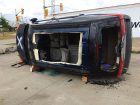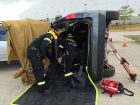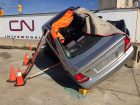
Extrication tips July 2017: Throwing SHADE on your size-up
By Chad Roberts
Features Extrication Training annex Canada extrication firefighterIn the April issue, we discussed roles of each responder and how to set a plan at a scene. No matter how simple or complex the incident, rescuers must start with a plan to assess the severity of the scene and the condition of the patient(s).
Once rescuers have established the scene, secured it from any further exposures, and identified patient(s), it’s time to create a safe environment for the rescuer and patient(s). To do this, crews must develop an incident action plan. When developing this action plan, the incident commander (IC) must constantly consider and reconsider the status of patient(s) and the best possible point of extrication.
With the patient(s) now identified and a dialogue established by the first-responding firefighter, the crew can begin to stabilize the vehicle to allow for the first-responding firefighter or a medic to enter the vehicle. It cannot be overemphasized that the vehicle needs to be stabilized properly before any rescuer can attempt to enter; this is to ensure the safety of the rescuer and reduce subsequent vehicle movement that could be detrimental to the patient(s). At this point, primary stabilization of four points of cribbing on the vehicle (minimum of three) must be established.
Once stabilization is achieved, rescuers can create an opening for the firefighter or the medic to enter the vehicle. When selecting a point on the vehicle, try to choose an opening that is both large enough for entry and as far away from the patient(s) as possible, for example, the rear window or a rear door if the patient is in the driver’s or front passenger’s position. Keep glass management in mind when entering. If windows must be broken, be sure to fully cover the patient or control the glass using windshield adhesives or tape.
With this step completed, and the firefighter/ medic is in the vehicle, rescuers can begin a more thorough assessment of the patient, gathering information about best possible removal options and the severity of the patient’s injuries. While this is going on, rescuers on the outside of the vehicle must prepare for extrication.
Glass management continues throughout the process, as the rest of the vehicle windows must to be removed before any tool work begins. Secondary stabilization can be addressed with additional cribbing or struts, depending on the position of the wreck. Space creation is one of the often overlooked, but this step must be completed; doing so can save valuable minutes and open up better avenues for patient removal. These steps are key to finalizing the extrication plan and determining how to create an opening for patient removal.
Once rescuers have decided on a plan, it’s a good idea to visualize the entire process. Whether the vehicle is on all fours, on its side, or even on the roof, rescuers must choose the opening that best suits the needs of the situation, while keeping in mind patient condition. Look at the kinetics of the incident and consider where the patient’s injuries might be. How will the metal bend or react when it is cut or pried? Every action has an equal or opposite reaction, so be careful which option you choose. Always remember to listen to crew members. Everyone in this profession has different skills and knowledge. No one is an expert at every type of incident, so develop trust with your crew and listen to suggestions.
A great way to remember all the necessary steps in the size-up process is to use the acronym SHADE.
- Size-up – this is where rescuers do inner/ outer circles, sizing-up possible patient(s) and the vehicle(s) involved.
- Hazards – identify any hazards, hybrid vehicles and hoseline placement for fire protection.
- Access – the steps necessary to access patients and complete a more thorough assessment.
- Disentangle – actions taken to disentangle patients by creating space (moving seats back, adjusting the steering wheel, removing head rests).
- Extrication – the necessary extrication process.
With this acronym in mind, every accident scene can be effectively managed. However, it’s a good idea to have two or three alternate action plans. In the October issue, we will discuss options for patient removal.
Until then, be smart and never stop watching, reading and listening.
Chad Roberts is a firefighter in Oakville, Ont., and works on a heavy rescue. He is a member of the Oakville’s extrication team and competes and trains across North America. chadroberts12@gmail.com
Print this page
Advertisement
- Well-being July 2017: Sweat the small stuff with infrared saunas
- Tim-bits July 2017: Stretching from the standpipe


